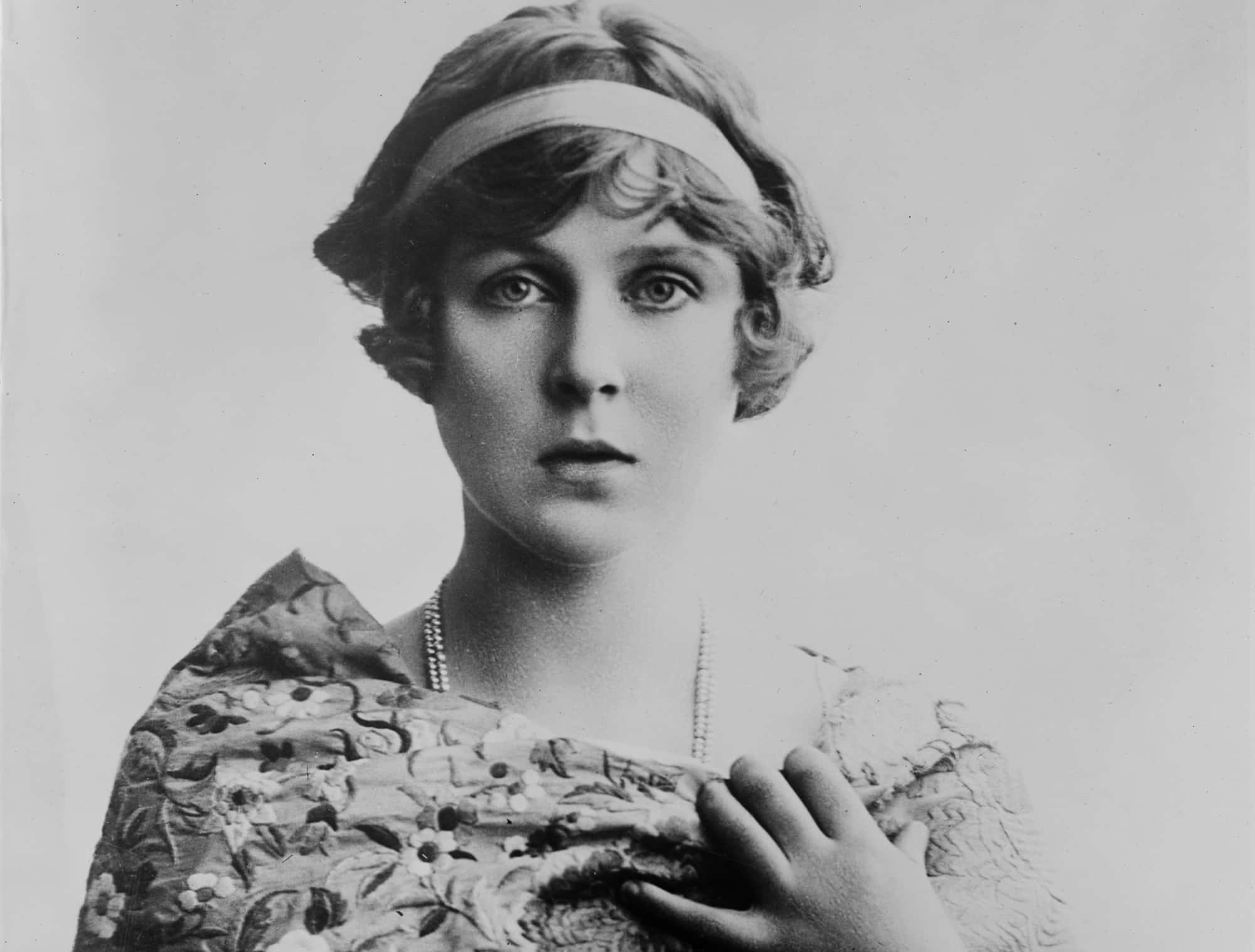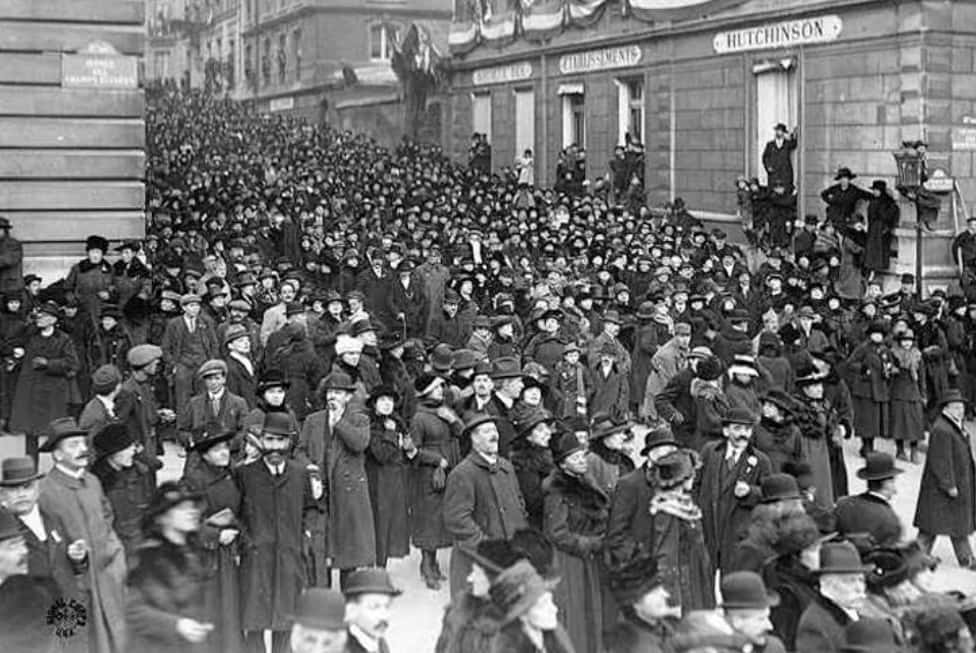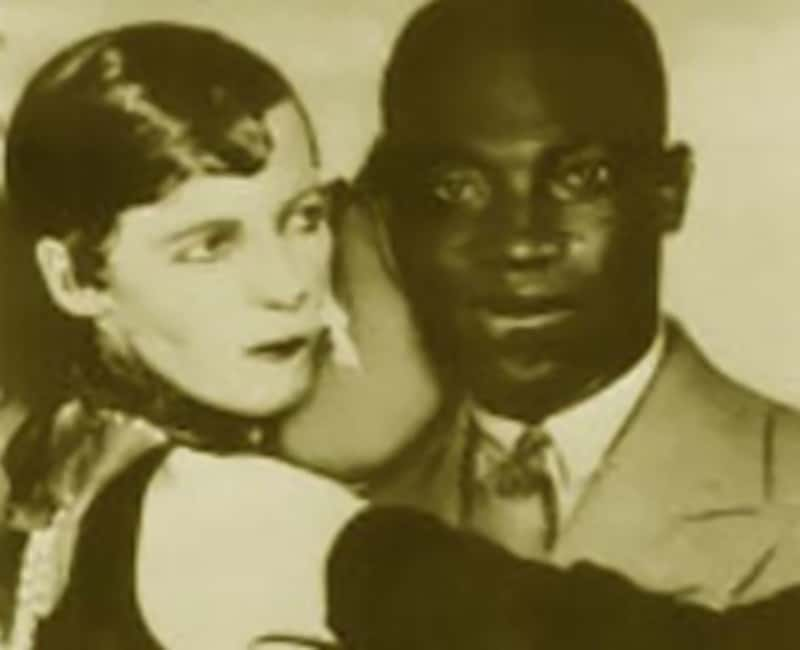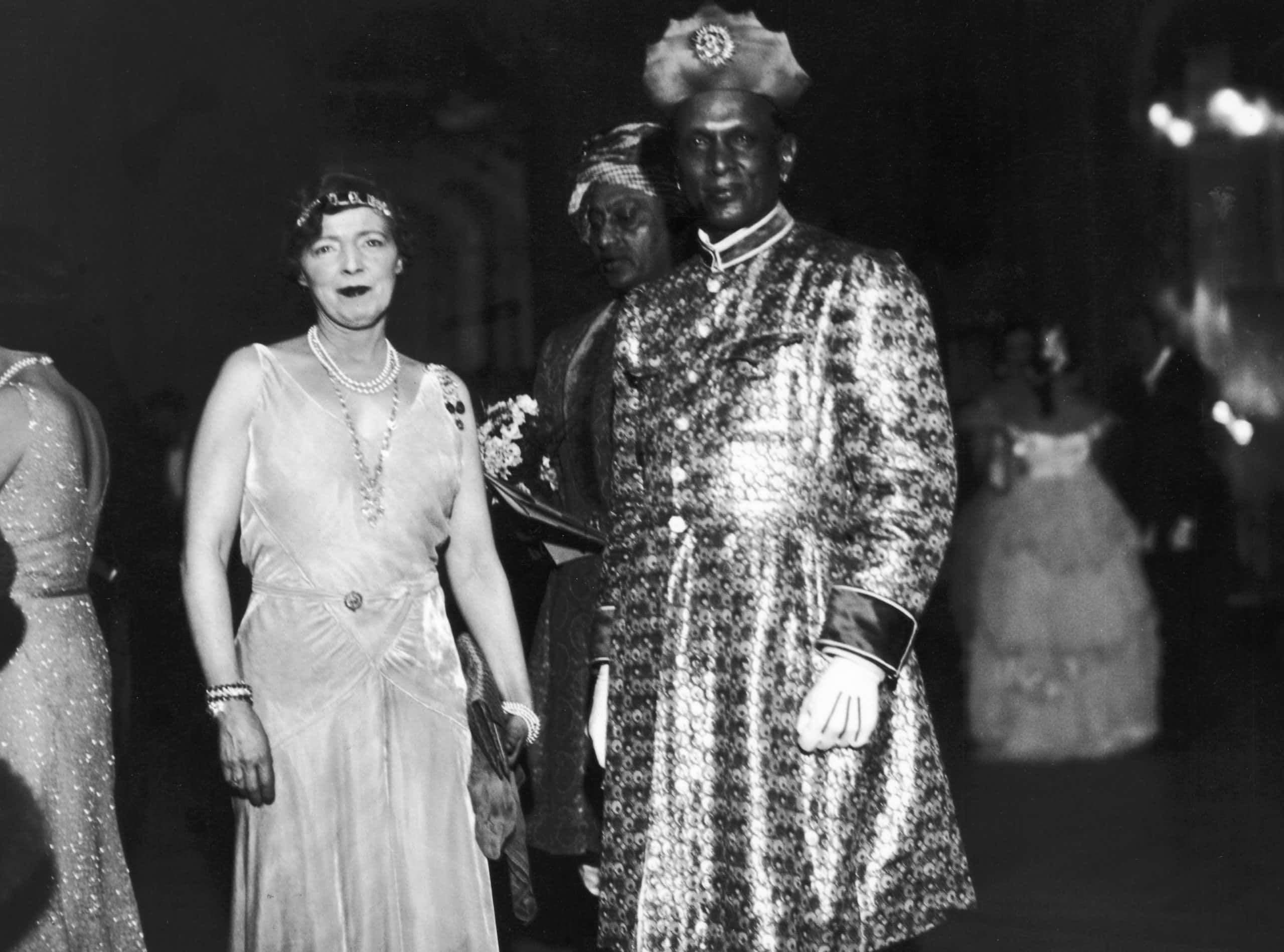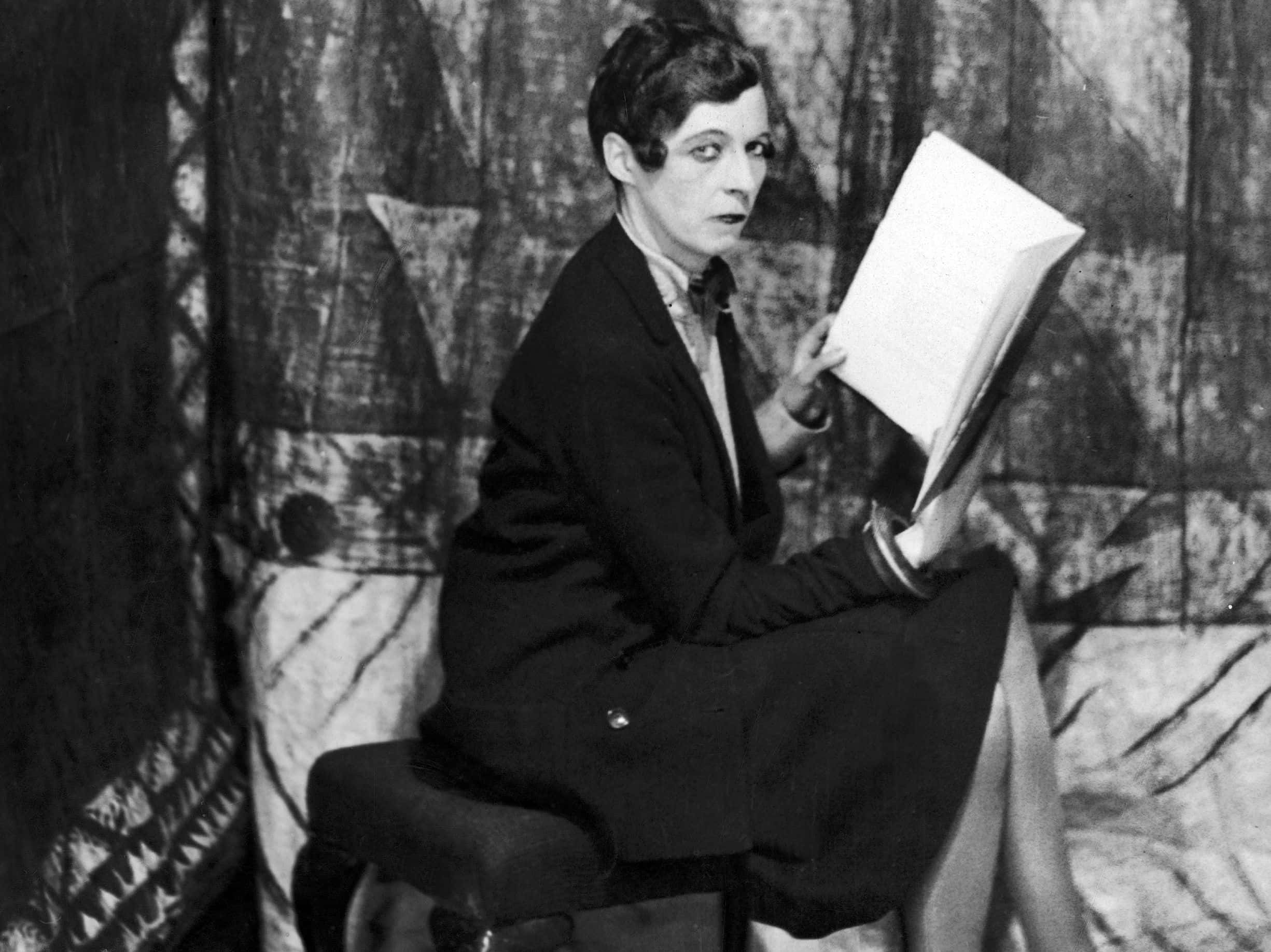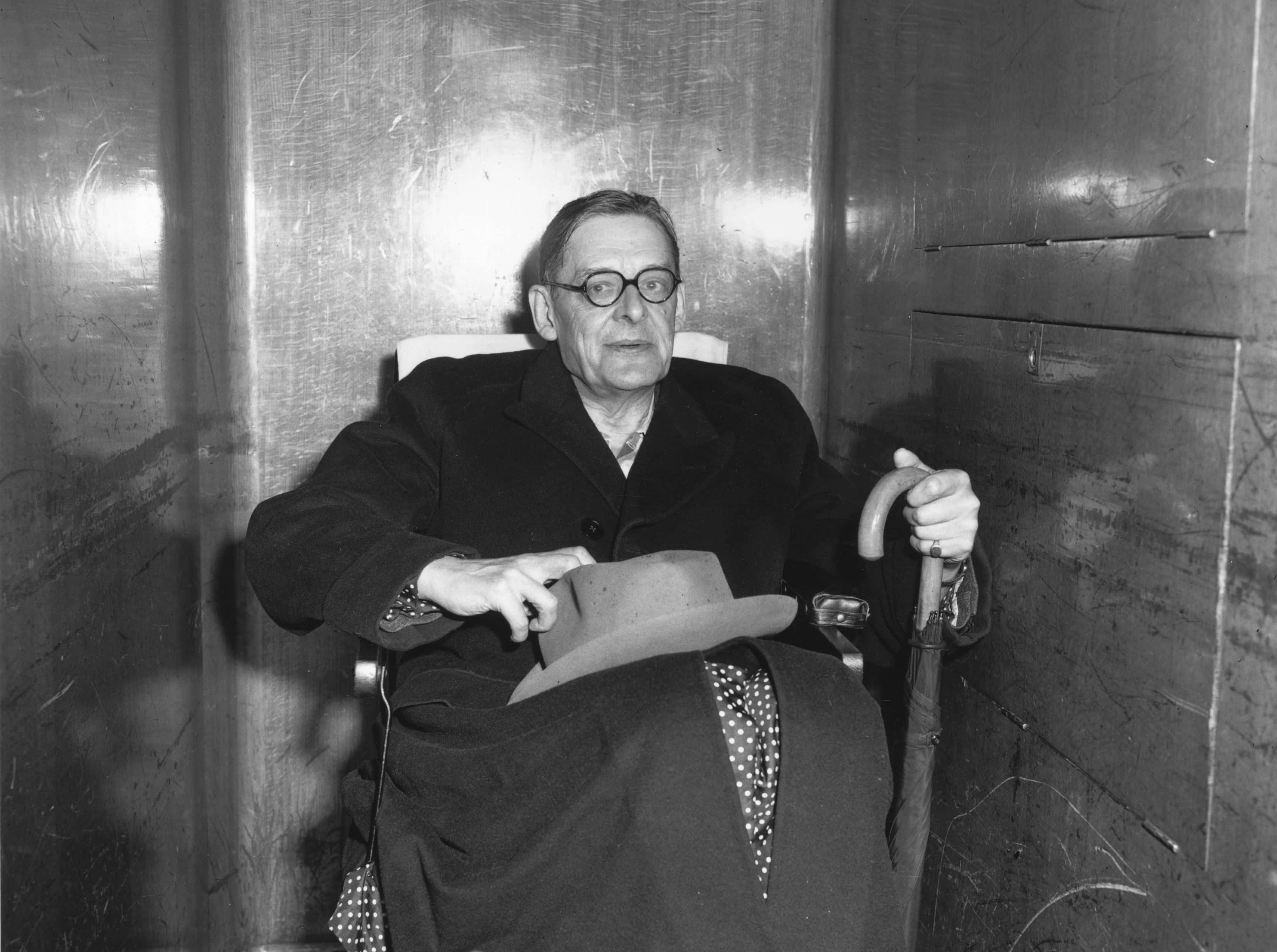The Rebel Heiress
A dazzling beauty, heiress to one of England’s greatest fortunes, and the toast of European society—Nancy Cunard was one of the queens of the Jazz Age, and she had a massive rebellious streak to boot. Yet for all her charmed beginnings, Cunard’s end was one of the most devastating in history.

1. She Was Heiress To A Famous Line
Nancy Cunard was the definition of a "poor little rich girl". On the surface, she had everything: Her father, Sir Bache Cunard, was heir to the famous luxury Cunard shipping line, while her mother, Lady Maud Cunard, was a society hostess of the highest elegance and intelligence. Yet despite their influence, the family hid their worst secrets behind closed doors.

2. Her Family Was A Mess
When Nancy was born on March 10, 1896, you’d think her extravagantly wealthy family would spoil the little girl with love, affection, and priceless gifts. Well, you’d be wrong: In truth, Nancy’s mother Maud despised everything about childbirth and child rearing, and only had Nancy—who would be her only child—because she believed it was her wifely duty.
As a result, Nancy grew up nearly neglected, "gifted and lonely," and was raised mostly by household staff. And that was just the start of it.
3. People Thought She Was A Love Child
There were deeper problems in the Cunard clan than a lack of motherly love. Nancy’s parents had married strictly for convenience, and the sporting Sir Bache had little in common with his refined, book-smart wife—so much so that there were rumors Nancy’s mother was having an affair with the novelist George Moore, and that Nancy was actually their love child.
Unfortunately, the truth is probably much different—and certainly much darker.
4. Another Man Raised Her
Despite the rumors, most historians discredit the idea that George Moore was Cunard’s father, seeing as Maud likely never let him consummate his love for her, and Moore was notorious as "one who told but didn’t kiss". Nonetheless, Nancy and Moore grew incredibly close as the girl grew up.
Eventually, he became one of the only father figures she had, especially after her parents separated in 1911. But this led to an incredibly gross breach of trust.
5. She Had An Inappropriate Childhood Relationship
Even when Nancy was a little girl, her adoptive father George Moore grew a little too close to his charge for comfort. He began bragging to Nancy about his other bedroom conquests aside from her mother, once boasting, "I would lay aside the wisest book to talk to the stupidest woman".
It set an unsettling template for the pair, especially since Nancy already had an unhealthy conception of boundaries and affection. Unsurprisingly, then, it didn’t take long for it all to unravel.
 Wikipedia George Moore
Wikipedia George Moore
6. Her Mother Treated Her Like A Creepy Doll
If there was one thing Nancy’s mother Maud did care about when it came to raising her daughter, it was making her look pretty. Ever since she was a child, Maud would order the servants to dress Nancy up like the subject of a painting—whether Velazquez or Edouard Manet—and then present the girl to her for her amusement. So imagine Maud’s delight when Nancy turned into one of the most strikingly beautiful women in England.
Tall, thin, and with soft blonde hair, Nancy also had shocking blue eyes that glared out from high cheekbones. Yet with such a shaky childhood, Nancy’s great beauty got her into even greater trouble.
7. She Undressed For A Much Older Man
When Nancy was still a teenager, her close confidant betrayed her in the worst way possible. George Moore, who was in his 60s at the time, amped up his creep factor from telling Nancy about his conquests to begging her to undress for him. Bone-chillingly enough, she eventually complied. Looking back, this may have been the beginning of the end.
8. She Was A Party Girl
Around this time, Nancy fell in with the notorious troublemaker Lady Diana Manners, who adored recreational use of chloroform—she called it "jolly old chlorers"—and helped found "The Coterie," a group of young British nobles with perfect manners and hard-partying ways.
The Coterie reveled in activities like 24-hour bashes, skinny-dipping in the Adriatic Sea, and generally embarrassing their well-to-do parents. Nancy ate it up, and it wasn’t long before she was rebelling in even bigger ways.
9. She Rebelled In A Big Way
Nancy had long felt stifled by her mother’s perfect parties and lavish dresses, but now she started openly expressing her distaste, once showing up to a gala in only a black evening coat and a white slip in place of a proper shirt and bottoms. Her mother was utterly scandalized, and tried to force Nancy away from the "dangerous, bohemian types" she favored.
But Nancy's new contrarian streak, which would last the rest of her life, was already as strong as steel. This only pushed her further away.
10. She Took Up With An Artist Set
Desperate to get out from under her mother, Nancy and another friend, the artist and model Iris Tree, moved in together in a studio flat near the then-libertine Bloomsbury area. Soon enough, Nancy had hosts of artistic types around her, and the rag-tag group often met at the restaurant the Eiffel Tower, which Nancy named her "carnal-spiritual home".
But for all this bohemian charm, a curse was beginning to descend on Nancy.
11. She Was Addicted To Intimacy
Iris Tree described this time in their friendship as full of "drink, cynicism, and unlimited promiscuity," and Nancy, always the first woman anyone noticed in a room, began absolutely tearing through the artists and writers around her, preferably after late nights downing coupes. Men and women, famous or not, she could seduce them all if she wanted.
For many, this would be a justified sowing of wild oats. But for the damaged, desperate Nancy, this drinking and carousing would turn into something much darker. She was now careening down a dangerous path, with no way to get out. Unfortunately, it was about to get much worse.
12. She Watched Her Lovers Perish
In 1914, while Nancy was in the middle of her heady Coterie days, catastrophe smashed her world to smithereens. With the coming of WWI, many of Nancy’s friends and lovers departed for the front, and many of them didn’t return. As the months wore on, Nancy grew as inured to this grim reality as she could. But life was about to throw her a stinging curveball.
13. She Met A Handsome Serviceman
In the middle of the fighting, Nancy met one of the loves and lights of her life: Peter Broughton Adderly. A member of the Grenadier Guards, Peter had a brightness and optimism that counter-balanced the pessimism of her Coterie, and he and Nancy fell into an all-consuming, five-day affair before he went back to serve. Their love story had a devastating ending.
14. She Lost Her Love In A Horrific Way
Nancy gave herself over body and soul to Peter Broughton Adderly—so when she found out that he perished in battle, just weeks before Armistice Day and the end of the conflict, she was beside herself with grief. Indeed, most biographers believe she never truly got over his loss.
Nancy’s carefully constructed paradise was going to pieces all around her…so it’s no wonder she made a disastrous decision.
15. She Went On An Awful Rebound
In 1916, Nancy Cunard did something that shocked even her hard-living friends: She went through a conventional marriage. The groom was the clean-cut, darkly handsome Australian cricketer Sydney Fairbairn, and if it seems like the romance happened quickly, that’s because it did.
Nancy plucked Fairbairn almost from thin air, prompting even her hands-off mother Maud to ask her if she was sure about going through with the marriage. Nancy’s lukewarm response? "I gave my word and I must". It did not end well.
16. She Tried To Have A "Perfect" Life
After a bizarre wedding ceremony on November 15 where Nancy’s mother insisted on showering the guests with silver coins—a painful, if lucrative ritual—Nancy and her new husband posted up in a sweet little house, and the heiress set about trying to live on the straight and narrow.
Surely, she thought, domesticity would fill the gaping hole WWI was still carving inside her heart. Instead, it only deepened it.
17. Her Marriage Fell Apart
In the end, Nancy and Sydney Fairbairn lasted only 20 months. Every one of those months was torment for Nancy, who was still rebounding from Peter Broughton Adderly, and she emerged from the union more scarred than ever. Certain there was no hope for her in the conventional set, she refused to move back into her mother’s estate after the split, and instead dove headfirst back into the bohemian life.
Yet even as Nancy tried to turn back time, there were already chilling signs of her tragic demise.
18. She Became Gravely Ill
In 1919, Nancy fell prey to the Spanish Influenza that swept through Europe after the war. Though she would survive the ordeal, she suffered the effects of the Influenza for years afterwards. That wasn’t all: press clippings from around this time also report the socialite’s issues with bronchitis, which her heavy smoking habit didn't help.
Though she was still young, eminently elegant, and arrestingly beautiful, the ravages of time were beginning to stick to Nancy. More than that, some so-called friends were beginning to turn on her.
19. An Ex Dealt Her A Cruel Insult
Nancy left a trail of broken hearts and fragile egos wherever she went, and her former or wannabe lovers began to grow jealous. After she snubbed the poet Richard Aldington, he got her back by memorably insulting her as a "lecherous octopus". Yet Nancy had cruel tendencies too. Another man wrote that he thought she derived "personal satisfaction" from hearing that a lovelorn man might kill himself over her.
Life, however, was just as cruel back to Nancy.
20. She Had A Botched Surgery
In 1920, Nancy went through one of the most harrowing ordeals of her young life. For reasons we’re still not sure of—perhaps a desire to not have children—she had a hysterectomy at just 24 years old. It took a terrifying turn for the worse. A slip-up in her surgery or recovery nearly ended her life, and the already ailing socialite had to crawl back the long road to recovery. Only, the real consequences came after.
21. She Fell Into Terrifying Habits
The operation was so harrowing, many believe Nancy began a true dependence on substances and drinking in the aftermath. Likely not coincidentally, it was also around this time that Nancy showed signs of a difficult relationship with her ailing body. Her chronic asthma was quickly turning into emphysema and she was constantly anemic. Yet when concerned doctors begged her to curb her bad habits, the freedom-loving heiress refused, once commenting that "One’s body should not be felt".
Besides, Nancy didn’t have time to slow down. She had much bigger plans.
22. She Made A Famous Publishing House
Nancy wasn't simply a muse for artists, she was also truly integral to their work. In addition to writing her own poetry, she founded The Hours Press in 1928, which quickly helped publish some of Modernism’s most famous heavyweights; among her stable of writers were Ezra Pound and Samuel Beckett. And that same year brought an even bigger change to Nancy Cunard’s life.
23. She Met The Love Of Her Life
In 1928, Cunard began a relationship with African-American jazz musician Henry Crowder—perhaps the only companion who ever held a candle to her lost love Peter Broughton Adderly. Nancy had long adored the freedom and excess of jazz music, and Crowder seemed to embody it all.
Despite the fact he was married, they sparked a relationship that would last nearly a decade. But it came with a hefty price tag.
24. Her Mother Hated Her Choice
The idea of one of the wealthiest white women in Europe dating a (married) Black jazz musician was shocking and undesirable to many in Nancy Cunard’s old, conservative social sphere, but no one was as incensed as her mother Maud. The matriarch’s response to the news was ice cold.
Maud asked, sniffing, "Is it true that my daughter knows a Negro?" and later threatened to have Crowder deported. For Nancy, however, this was only fuel to the fire of her passion for Crowder. That passion was about to explode.
25. Her Whole Life Changed
It's impossible to overstate the change Crowder ushered in for Nancy, and Cunard herself would later admit "Henry made me". The musician was particularly instrumental in alerting Nancy to the prejudices Black people faced, as well as to the burgeoning Civil Rights movement.
Nancy took to social justice like a duck to water, and she soon became one of the loudest and most impassioned voices in her social circle for equality. In 1934, she even worked together with her Black artist friends, among them Langston Hughes and Zora Neale Hurston, to publish the anthology Negro. Yet during this period of her life, she is still remembered for a much different signature.
26. She Invented A Signature Style
Nancy’s relationship with Crowder coincided with her fascination with African art, particularly African jewelry. Ever the trend-setter, the svelte Nancy began wearing massive bracelets of wood, bone, and ivory from her wrists all the way up to her elbows, so that the jewellery nearly swallowed her up".
Polite" white society, already stunned at Nancy’s defense of basic human rights, began to roundly ridicule her for the choice. Then when they did come around on her sartorial choices, they problematically but triumphantly dubbed it the "barbaric look". Even so, few knew the disturbing truth behind Cunard’s iconic bracelets.
27. She Was Violent In The Bedroom
Nancy and Crowder’s relationship was, like so many of her affairs, a volatile one full of fights and reconciliations. Reportedly, though, Nancy liked to fight dirty: Some claimed she used these bracelets as weapons during their more fiery rows. A friend once saw Crowder in the street sporting bruises on his arms; when they questioned him about it, he replied "Just bracelet work".
In many ways, Nancy Cunard was at the height of her influence, but also the depths of her despair. And she was hiding a big secret.
28. She Was Hiding A Ruinous Secret
When Nancy’s anthology Negro came out, it faced dismal sales numbers—which should have been nothing for an heiress of the Cunard fortune. Only it was a huge deal. That's because in the wake of her relationship with Crowder, Nancy’s family had all but disowned her, cutting her off from their fortune. Meanwhile, she had financed the book with her own money.
Though the press hardly knew it, Nancy Cunard was broke and alone. Sadly, she was about to need more support than ever.
29. She Was A Bona-Fide Anarchist
When Nancy Cunard committed, she committed, and she took her status as an ex-heiress extremely seriously. Over the next decades, especially with the rise of first the Spanish Civil War and then WWII, Nancy devoted herself fully to an anti-Fascist, often anarchist lifestyle and succeeded in making herself an enemy of the government.
The authorities would detain her countless times, but each experience only made her a louder opponent of injustice. This, it's true, was heroic. Yet Nancy’s personal life was becoming a Greek tragedy.
30. She Began To Turn Desperate
As Nancy approached middle age, she kept the good looks that had always drawn men and women toward her, but she began to lose her devil-may-care attitude about love and passion. After she and Crowder drifted apart, she often took up with men who were decades younger than her, only to suffer through immense insecurity and heartbreak when these men dropped her.
As it turned out, these emotional periods may have been the first signs of a looming, vicious mental breakdown.
31. She Displayed Bizarre Behavior
In 1956, when Nancy was 60 years old, she underwent a terrifying transformation. Always justifiably suspicious of the authorities since the beginning of her decades-long career as a radical, she nonetheless began to exhibit something of a persecution mania to anyone in a uniform, and got into altercation after altercation with officers wherever she went. The worst, however, was yet to come.
32. She Performed Deranged Antics
During these years, Nancy’s behavior turned more and more non-sensical. Stories emerged of the former debutante coming out of an Italian café after a night of heavy drinking with a smoke stuffed up each nostril, whereupon she began pelting stray dogs with tomatoes. Other tales told of her sitting down on a train and, when an attendant asked for her ticket, eating it in defiance.
Then one day, it all hit a ruinous climax.
33. She Got Exiled
Nancy had made a permanent home in Spain at this time, and loved to openly criticize its Head of State, Francisco Franco. This enmity only made her more volatile to Spanish officials, and in 1960 the country expelled her once and for all after yet another altercation with its authorities. And that’s when her downward spiral truly began.
34. She Had A Tragic Homecoming
When Spain kicked her out, Nancy still had much to lose. She had just taken up with the 27-year-old silversmith and artist Tomas Canas Morales, but had to leave him behind and return to London, alone and somewhat with her tail between her legs—at least as much as the fiercely independent Nancy Cunard could manage.
The change did her no good, and soon even worse stories were circulating about her.
35. She Was Volatile
While in London, Nancy outdid her previously erratic behavior in a tragic way. One story claimed that during a cab ride home one night, almost certainly after long hours of drinking, Nancy got into a fight with the driver and ended up using a flamethrower dating from the Spanish Civil War to torch his car. Yet as always, the worst damage Nancy did was to herself.
36. Her Body Was Failing Her
By this time, it seemed that Nancy Cunard was beyond saving. Her friends noticed she was "wan and worn," was eating even less than usual—she had never been overly fond of food or any bodily needs—and her anemia and asthma had only worsened as she aged. But Nancy was her own worst enemy, and she was about to burn the few bridges she had left.
37. She Made A Shocking Midnight Visit
With little to her name and a rapidly deteriorating mental state, Nancy got it into her head that she had to see an old friend, the novelist and screenwriter Anthony Thorne—despite the fact it was midnight and Thorne was out of town. When she arrived at the house, his wife Hume answered the door, only to find that Nancy had lost all her luggage and money before getting into yet another fight with the cab driver, who now wanted Hume to pay the fare.
But that was just the beginning. Hume Thorne soon got a painful view of just how far Nancy Cunard had fallen.
38. She Was Losing Her Mind
Throughout this long, dark night of the soul, Nancy seemed barely tethered to reality. The ex-heiress started eating a sandwich from a paper bag, only to throw the crusts into the Thornes’ unlit fireplace and then attempt to throw an expensive ashtray along in with them. She later burned what few belongings she had left. The next morning, Nancy Cunard sealed her fate.
39. She Hit Rock Bottom
The next day of Cunard’s life is something of a blur. She left the Thornes’ house early, wearing the remaining African necklaces and bangles that she had managed to keep in her possession. While wandering around, she got into a fight with an officer, and went on to throw her shoes at the magistrate in her court appearance. Unsurprisingly, they promptly threw her behind bars.
For 10 days, no one could find Nancy Cunard, once one of the most visible women in the world. When her family finally tracked her down, they came to a heartbreaking and notorious decision.
40. Her Family Forced Her Into An Asylum
Nancy’s mental breakdown had been coming on for months, even years, but now it was undeniable to almost everyone who knew her. At long last, on the advice of a physician but against his conscience, her cousin Victor Cunard agreed to have Nancy committed to an asylum and certified insane.
To this day, Nancy’s mental illness is a defining part of her story. But the reality may be quite different.
41. She Made A Miraculous Recovery
After her admittance into the asylum, a strange miracle occurred. At the start, Nancy was certainly experiencing some break from reality, and wrote some of her friends irrational letters displaying only semi-coherent thoughts that blamed her predicament on her Fascist enemies. But within days, she was better, which likely rules out significant psychosis.
This, however, doesn’t mean that everything was on the up and up for Nancy. Instead, it points to a more disturbing truth.
42. There Was A Reason For Her Illness
Although Nancy kept blaming Franco’s "Spain and all its doings" for her stay at the asylum, her own friends believed something more sinister. They felt that her mental breakdown was due to her serious issues with booze, and that if she stopped drinking, she would significantly improve.
Sadly, no one could stop Nancy from doing a single thing she wanted to do. As soon as they released her—after she had gained weight and some of her health back—she continued drinking a lot and eating very little. Then came one of the final tragedies of her life.
43. She Went Through A Painful Breakup
Throughout her stay at the asylum, Nancy fixated on her much-younger lover Tomas Canas Morales. As she wrote, "I want him here, with me, as close as can be, FOR EVER". But even this dream came crashing down. When she reunited with him, they quickly discovered they were incompatible. They split up soon after, in July 1961. He would be the last significant relationship of Nancy’s life.
44. She Spiraled Out Of Control
From then on, Nancy deteriorated with a rapidity even she had never experienced before. She had great difficulty sleeping and suffered a series of falls that left her almost unable to walk. Unfortunately, this didn’t stop her from completely ignoring the pain and somehow getting herself on trans-Atlantic flights, or dragging herself upstairs in unbearable scenes that lasted for hours.
45. She Burned Most Of Her Bridges
In the throes of her physical decline, Nancy continued to alienate friends. She would accept their hospitality and invitations to stay with them, but then quickly find ways to self-sabotage and move out. Meanwhile, she often felt they had abandoned or injured her.
Right before her stunning end, she accused her old friend and lover Raymond Michelet of sending a spy to her hotel room. In reality, he had only sent a doctor. One, it turned out, that she very much needed.
46. Her Final Days Were Catastrophic
On March 13, just a few days after her 69th birthday, Paris authorities made a gruesome discovery. Nancy was unconscious on the street. Apparently, she had again attempted to walk around the city when her body was in no shape to move in the slightest. This time, however, she had no luck left.
47. She Died Alone
Even when Nancy regained consciousness shortly after officers took her to the hospital, she didn’t know her own name. Confused and asking attendants for wine they wouldn’t bring her, she fell into a coma soon after. She passed on, penniless and alone, in the hospital’s oxygen tent. She weighed just 57 pounds at the time of her passing.
Yet the final tragedy was still on its way.
48. Her Family Abandoned Her
Nancy Cunard had once been a dazzling socialite, but her funeral was a quiet, even sordid affair. No one from her remaining family made it out to say goodbye. Indeed, only a handful of friends swallowed their injuries and resentments enough to pay their respects. Her final resting place is the Cimetière du Père-Lachasse in Paris.
49. She Could Have Been Queen Of England
According to one of Nancy’s biographers, the socialite even caught the attention of the future King Edward VIII. Had Nancy reciprocated the prince’s feelings, she could have gone on to become the Queen of England. But playing by the prim and proper rules of the royal family was never in the cards for someone like Nancy Cunard.
50. She Slept With A Literary Celebrity
Nancy Cunard had some of the most sizzling affairs of her day, but few remember her most scandalous conquest. She actually had an affair with the literary titan TS Eliot, whose poem The Waste Land many consider among the best in the English language.
Eliot, who was fusty, uber Catholic, and married, was scornful at best of their brief dalliance. Perhaps that's why Nancy kept it as hush-hush as she could. Only in a late letter did she write winkingly, "Yes I DID know Eliot. I knew him. AND HOW!"
51. Her Lover Betrayed Her
Henry Crowder was the One That Got Away for Nancy Cunard. But years later, her old lover dealt her a cruel betrayal. He wrote a scathing memoir, As Wonderful as All That?, kissing and telling on their entire relationship. In it, he also lambasted Nancy as an ignorant and angry alcoholic who had constant affairs and then flaunted the trysts in his face. Ouch.







